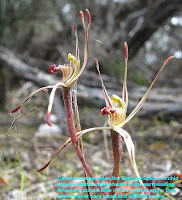Currently my flora blog covers hundreds of species, but includes realitively few details of the habitats they call home. Although many species are very adaptable and can be found in a number of habitats, there are many others that are highly habitat specific and will only be found in a certain area. This habitat preference apart from climatic factors, is often the result of different soils and substrates.
There are around 30 distinct large scale habitats in the Esperance region, which I have divided into coastal and inland, the latter being more than 50 km or 30 miles from the coast. This 50 km distance is also the region where the average rainfall drops below 40 cm (16”) per annum.
For comparison, the average coastal annual rainfall around Esperance is 60 cm (24”) and the furthest inland region covered here (160 km or 100 miles) is approximately 25 cm (10”) a year. This rainfall difference is sufficient to change the character and species composition of similar habitats in each zone, hence the distinction made here.
Due to the amount of work required to produce the habitat posts, they will not appear as regularly as the flora ones, but I hope to do one every 4-6 weeks.
This low-lying granite habitat is common to the NE of Esperance, but less so elsewhere. The outcrops are usually lower in stature than surrounding country, but may have high points to a few metres/yards in height. Rainwater flows or seeps onto these rocky platforms to form rock-pools or extensive areas of shallow water that will invariably evaporate during summer and in the low inland rainfall conditions of this region, can remain dry for several years.
Click image to enlarge
The tall eucalypts of the surrounding country indicate the edge of the granite area, where the soil structure is most commonly replaced by a fine sand/clay loam over limestone (N and NE of Esperance) or gravel to the NW. The trees exist here because their roots can deeply penetrate the normally crumbly limestone substrate, whereas soils over the granite are usually too shallow and any deep fissures few to non-existent.
Despite the bare rock and shallow soils being unable to support larger vegetation, this habitat does support extensive herbfields comprised of many annual and ephemeral species. These are fed by run-off from the slightly higher surrounding country and/or the rock itself; this over time gently washes down a fine silt that accumulates to produce a shallow, but stable soil to support a wealth of small herbs.
The fine sediment can also build up to form a dam wall at the lowest level, which in turn increases the depth of the catchment area. In contrast, water run-off from the large granite outcrops is stronger and will wash this fine sediment off the rock altogether and in so doing create a markedly different habitat from that of these smaller less elevated outcrops.
Water that collects in the lower parts form ponds and rockholes that can last well into summer. The deeper water poundages can sometimes support short-lived brine-shrimp like crustaceans and various aquatic insects, plus the local frog population waste no time in producing tadpoles, all of which attract herons, plus a variety of other wildlife to take advantage of the fresh pick of green herbs.
Because of this wildlife abundance, pre-European Aborigines took hunting advantage of this resource, whilst the women would seek treats from the high flora diversity of these areas. Sadly, although much of the flora remains intact for us to admire, most of the small animals have locally gone extinct due to fox and feral cat predation.
Further details of the flora shown above are available on the following links:
Acacia dempsteri
http://esperancewildflowers.blogspot.com.au/2011/01/acacia-dempsteri.html
Asteridea athrixioides - Wirewort
http://esperancewildflowers.blogspot.com.au/2010/10/asteridea-athrixioides-wirewort.html
Bossiaea walkeri - Cactus Pea
http://esperancewildflowers.blogspot.com.au/2010/01/cactus-pea-bossiaea-walkeri.html
Caladenia microchila - Western Wispy Spider Orchid
http://esperancewildflowers.blogspot.com.au/2008/09/western-wispy-spider-caladenia.html
http://esperancewildflowers.blogspot.com.au/2011/01/acacia-dempsteri.html
Asteridea athrixioides - Wirewort
http://esperancewildflowers.blogspot.com.au/2010/10/asteridea-athrixioides-wirewort.html
Bossiaea walkeri - Cactus Pea
http://esperancewildflowers.blogspot.com.au/2010/01/cactus-pea-bossiaea-walkeri.html
Caladenia microchila - Western Wispy Spider Orchid
http://esperancewildflowers.blogspot.com.au/2008/09/western-wispy-spider-caladenia.html
Caladenia sigmoidea - Sigmoid Spider Orchid
http://esperancewildflowers.blogspot.com.au/2008/09/sigmoid-spider-orchid-caladenia.html
Dodonaea lobulata - Bead Hopbush
http://esperancewildflowers.blogspot.com.au/2012/06/dodonaea-lobulata-bead-hopbush.html
Glycine peratosa
http://esperancewildflowers.blogspot.com.au/2010/03/glycine-peratosa-fabaceae.html
Melaleuca elliptica - Granite Bottlebrush
http://esperancewildflowers.blogspot.com.au/2009/03/granite-bottlebrush-melaleuca-elliptica.html
Ophioglossum lusitanicum - Adders Tongue
http://esperancewildflowers.blogspot.com.au/2011/06/ophioglossum-lusitanicum-adders-tongue.html
Prasophyllum macrostachyum - Laughing Leek Orchid
http://esperancewildflowers.blogspot.com.au/2008/09/laughing-leek-orchid-prasophyllum.html
http://esperancewildflowers.blogspot.com.au/2008/09/laughing-leek-orchid-prasophyllum.html
Pterostylis mutica - Midget Greenhood
http://esperancewildflowers.blogspot.com.au/2008/09/midget-greenhood-pterostylis-mutica.html
http://esperancewildflowers.blogspot.com.au/2008/09/midget-greenhood-pterostylis-mutica.html
Pterostylis scabra - Shell Orchid
http://esperancewildflowers.blogspot.com.au/2011/07/pterostylis-scabra-shell-orchid.html
Santalum acuminatum – Sweet Quandong
http://esperancewildflowers.blogspot.com.au/2013/04/santalum-acuminatum-sweet-quandong.html
http://esperancewildflowers.blogspot.com.au/2011/07/pterostylis-scabra-shell-orchid.html
Santalum acuminatum – Sweet Quandong
http://esperancewildflowers.blogspot.com.au/2013/04/santalum-acuminatum-sweet-quandong.html


+of+Melaleuca+elliptica++010.jpg)



+of+Habitats+-+Inland+Low-lying+granite++007.jpg)

+of+Santalum+acuminatum++004++Quandong.jpg)


+of+Dodonaea+lobulata++004++Bead+Hopbush+-+Copy.jpg)
+of+Bossiaea+walkeri++005A.jpg)

+of+Bossiaea+walkeri++006A.jpg)









+of+Acacia+dempsteri++001.jpg)




+of+Asteridea+athrixioides++004.jpg)

+of+Acacia+dempsteri++003.jpg)
